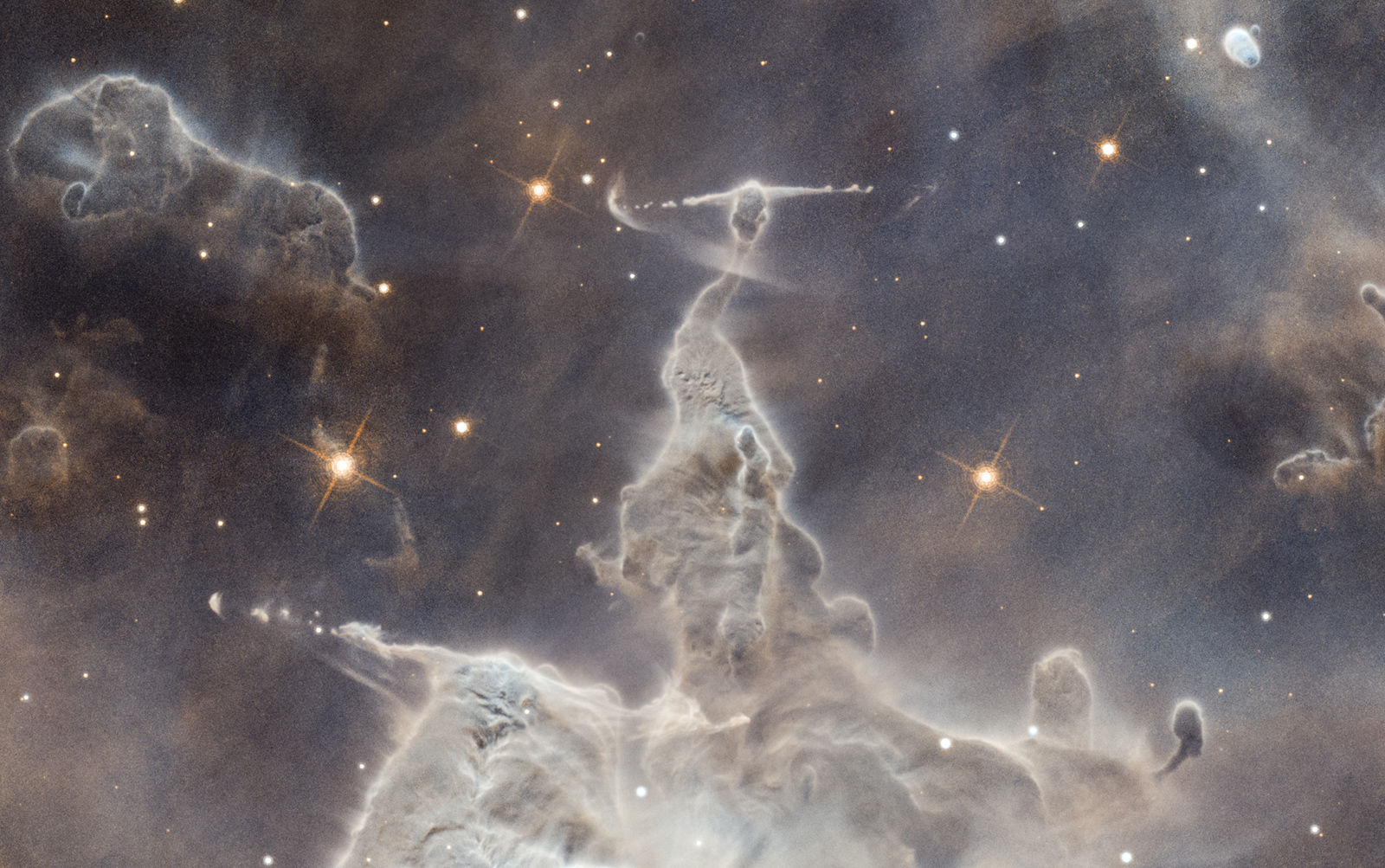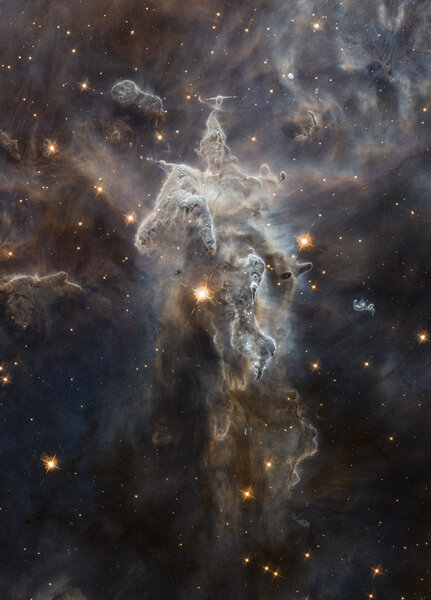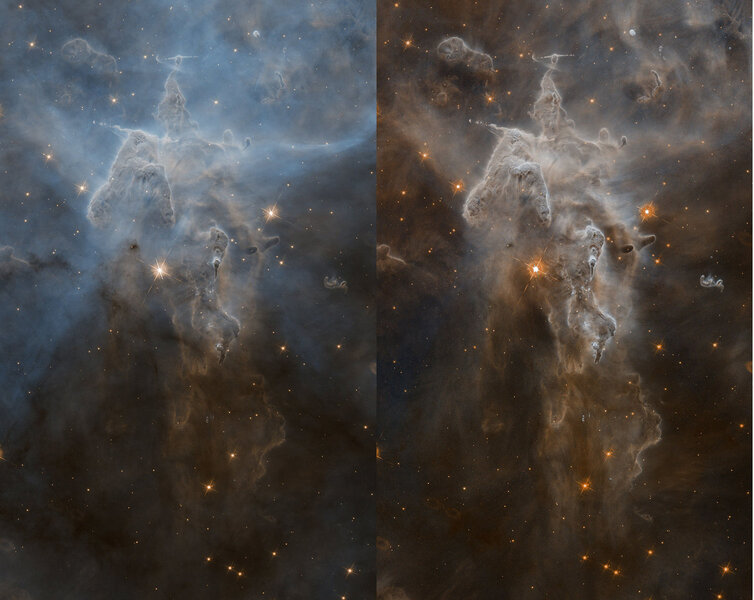Create a free profile to get unlimited access to exclusive videos, sweepstakes, and more!
Hubble's gorgeous 'Mystic Mountain' remastered

In 2010, on the 20th anniversary of the launch of Hubble Space Telescope into orbit, astronomers and artists put together a stunning image of a small piece of the vast Carina Nebula. The whole nebula is beyond enormous, but Hubble was looking at one part of it where young stars are being born.
I wrote about this at the time, and the original images are there, too.
I bring this up again, nearly ten years later, because Judy Schmidt, aka Geekzilla, has turned to these images to essentially remaster them; using the original data and combining them in her own way to create a color image. She is, well, a master at this, so feast your brain on what she did:
Yegads. Isn't that spectacular? Not only that, but her image uses the full dataset, which extends down well below what the original release showed. I wasn't even aware the original one didn't have the whole image in it!
The original one has much brighter and more vivid colors, so it is certainly attention-grabbing. But Schmidt’s are more subdued, subtle, and in fact I think they make you focus more on the fine structure of the nebula, taking in more of what’s going on there.
And what is going on there? I describe it in my original article, but to recap, this is a region where stars are being born. This happens in big nebulae where the gas is thickest, where the gravity of a small pocket can overcome its internal heat and collapse. This process is mind-grindingly complex, but the gist of it is that in the center of the collapse the gas gets so dense it ignites nuclear fusion, transforming hydrogen into helium, which is the definition of a star.
When the star is still forming it’s what we call a protostar. It can have strong magnetic fields and spin very rapidly. This winds up the magnetic field lines above the spin poles, and material can get caught in that maelstrom and flung away from the star at high speeds. This creates two beams or jets of material that can stretch for many light years. These are called Herbig-Haro objects, and there are several in the images. The most obvious one is right at the top.
I think it looks like a creepy alien head. On the left the material is slamming into gas and dust in the nebula, creating that huge bow shock pattern. There’s one on the right, too, though much weaker. Perhaps the nebular material is thinner there.
The original name for this whole piece is Mystic Mountain, because it looks like lots of mountains stacked up. Astronomers call these structures "elephant trunks," and they're caused by bright stars above and out of frame. The tremendous luminosity of these stars east away at the material in the nebula. Where there’s a dense knot or clump the material can persist downstream, and you get these long structures all pointing toward the luminous stars. This kind of thing was first made famous in the "Pillars of Creation" Hubble image.
When Schmidt posted these to her Twitter feed, she mentioned she was having an issue with putting the images together to make a nice, balanced color picture. We chatted about it, and she told me it was when she subtracted off one particular observation from the others that made things work out.
Interesting. Atoms emit light in very specific colors, like hydrogen at 0.6563 microns, which is red, and oxygen at 0.5007 microns, which is green (they emit at many colors, actually, but these are strong ones in nebulae).
That particular color from oxygen only comes from gas that is extremely low density. Other atoms in the gas at that density emits in other colors as well, and tends to be dispersed across nebulae like this. So in the images it makes a fog of light.
Digital astronomy images are just numbers, where each number is the brightness of a pixel. If you use, say, a red filter to make the observation, the image tells you the brightness in that red color. You can literally subtract one image from another, and the result can help you understand the observations better. In this case, she subtracted the oxygen image, which — because it maps that low-density gas — removed the fog from the images.
Here's the original she did and the one cleaned of fog:
See? The left image shows the low-density gas, and while it’s scientifically very interesting it hides the structures a bit. So when it’s removed you get that very sharp image.
Subtracting images can be useful when you want to get rid of a star, for example, if it's surrounded by faint material. You can observe another star that doesn’t have anything around it, and subtract it from the image that does. What you’re left with is just the faint material. It’s is nowhere at all that easy — I have done this with Hubble and there are approximately a billion variables that make this hard — but it's possible. Sometimes the result is a little messy, but useful to analyze for science. There are lots of other reasons this can be done, too.
Schmidt did it for beauty. I'm OK with that! The original data are still perfectly fine for scientists to analyze and try to understand star birth, but those same images processed in a different way are then perfectly fine — even outstanding — for us to let soak into our brains.

















